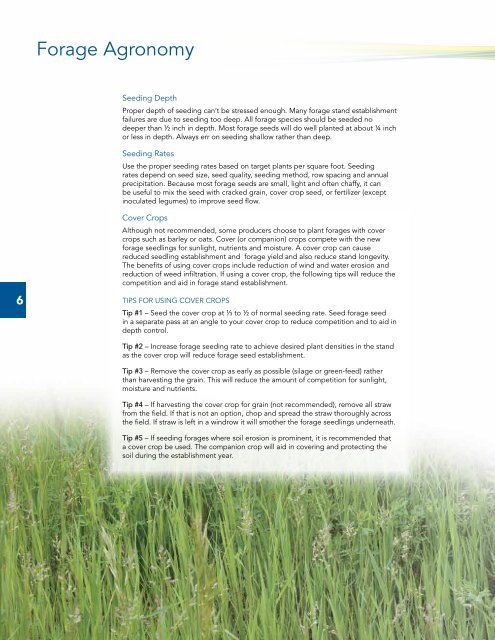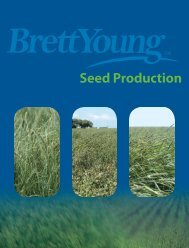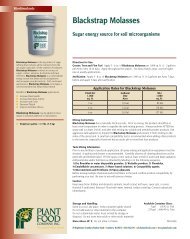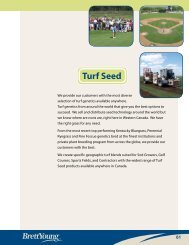2012 Fo r a g e g u id e - BrettYoung
2012 Fo r a g e g u id e - BrettYoung
2012 Fo r a g e g u id e - BrettYoung
You also want an ePaper? Increase the reach of your titles
YUMPU automatically turns print PDFs into web optimized ePapers that Google loves.
<strong>Fo</strong>rage AgronomySeeding DepthProper depth of seeding can’t be stressed enough. Many forage stand establishmentfailures are due to seeding too deep. All forage species should be seeded nodeeper than ½ inch in depth. Most forage seeds will do well planted at about ¼ inchor less in depth. Always err on seeding shallow rather than deep.Seeding RatesUse the proper seeding rates based on target plants per square foot. Seedingrates depend on seed size, seed quality, seeding method, row spacing and annualprecipitation. Because most forage seeds are small, light and often chaffy, it canbe useful to mix the seed with cracked grain, cover crop seed, or fertilizer (exceptinoculated legumes) to improve seed flow.6Cover CropsAlthough not recommended, some producers choose to plant forages with covercrops such as barley or oats. Cover (or companion) crops compete with the newforage seedlings for sunlight, nutrients and moisture. A cover crop can causereduced seedling establishment and forage yield and also reduce stand longevity.The benefits of using cover crops include reduction of wind and water erosion andreduction of weed infiltration. If using a cover crop, the following tips will reduce thecompetition and a<strong>id</strong> in forage stand establishment.Tips for Using Cover CropsTip #1 – Seed the cover crop at 1 ⁄3 to ½ of normal seeding rate. Seed forage seedin a separate pass at an angle to your cover crop to reduce competition and to a<strong>id</strong> indepth control.Tip #2 – Increase forage seeding rate to achieve desired plant densities in the standas the cover crop will reduce forage seed establishment.Tip #3 – Remove the cover crop as early as possible (silage or green-feed) ratherthan harvesting the grain. This will reduce the amount of competition for sunlight,moisture and nutrients.Tip #4 – If harvesting the cover crop for grain (not recommended), remove all strawfrom the field. If that is not an option, chop and spread the straw thoroughly acrossthe field. If straw is left in a windrow it will smother the forage seedlings underneath.Tip #5 – If seeding forages where soil erosion is prominent, it is recommended thata cover crop be used. The companion crop will a<strong>id</strong> in covering and protecting thesoil during the establishment year.






